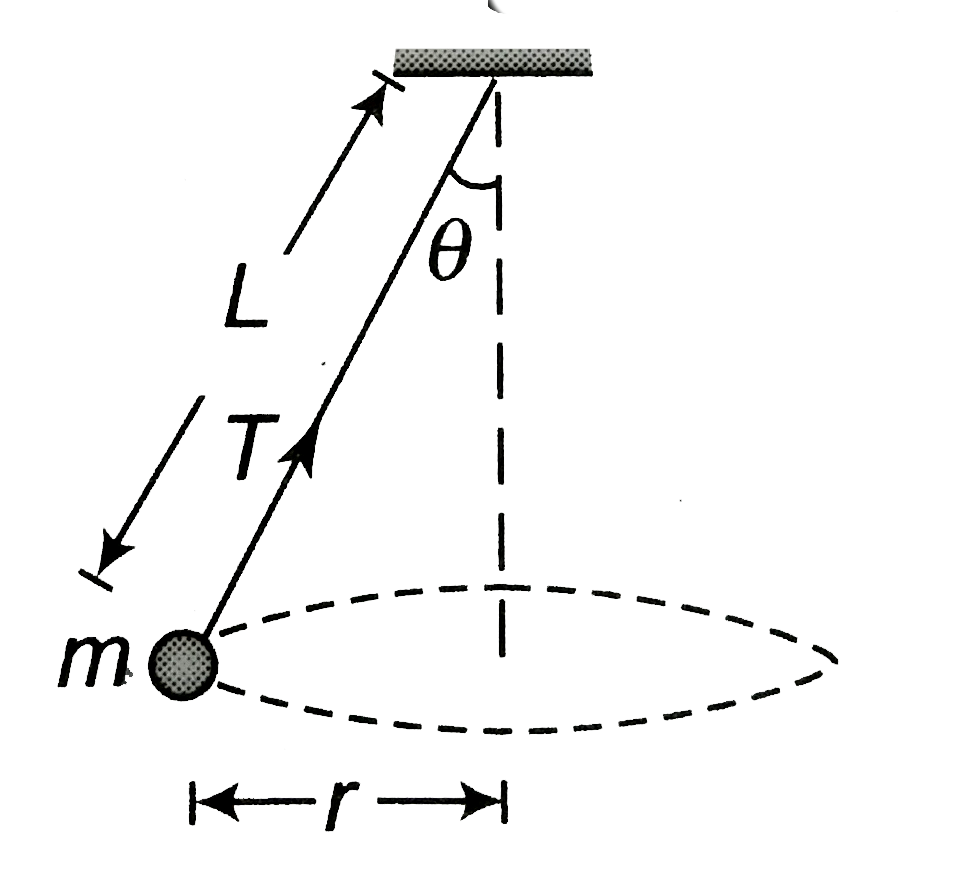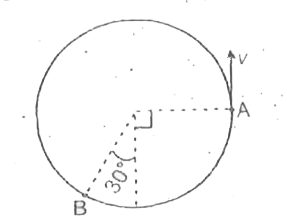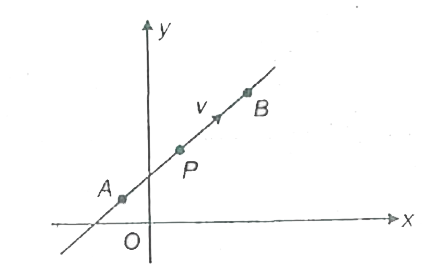A particle of mass 'm' moves on a horizont smooth line AB of length 'a' such that when particle is at any general point P on the line two force act on it. A force mg(AP)a towards A and another force 2mg(BP)a towards B.
Find the minimum distance of the particle from B during the motion.
a6
a4
a3
a8
The correct Answer is:A
(i) force on particle at point P
f=2mg(a−x)a−mg(x)a
F=mga(2a−3x)
m F=−3mga(x−2a/3)

(ii) So this is equation of S.H.M.(F=mω2x) so particle
Perform S.H.M. with mean position x−2a/3=0
So ω2=3ga⇒ω=√3g/a
So Time period T=2π√a/3g
and amplitude =2a/3−a/2=a/6
(iii) minimum distance from B
=a−(2a/3+a/6)=a/6
(iv) at point P velocity of partivle =0
and force =2mgxa
(at point q)
acc. =2gxa⇒v∫ovdv=a/6∫o2gxdxa⇒V=√2ga6

Topper's Solved these Questions
- BOOK - RESONANCECHAPTER - SIMPLE HARMONIC MOTION EXERCISE - Exercise- 3, PART - I20videos
SIMPLE HARMONIC MOTION
- BOOK - RESONANCECHAPTER - SIMPLE HARMONIC MOTION EXERCISE - Exercise- 3, PART - II17videos
SIMPLE HARMONIC MOTION
- BOOK - RESONANCECHAPTER - SIMPLE HARMONIC MOTION EXERCISE - Exercise- 2, PART - III12videos
SIMPLE HARMONIC MOTION
- BOOK - RESONANCECHAPTER - SEMICONDUCTORSEXERCISE - Exercise 388videos
SEMICONDUCTORS
- BOOK - RESONANCECHAPTER - TEST PAPERSEXERCISE - FST-330videos
TEST PAPERS
Similar Questions
A particle of mass 4kg moves between two points A and B on a smooth horizontal surface under the aciton of two forces such that when it is at a point P, the forces are 2→PAN and 2→PBN. If the particle is released from rest at A, find the time it takes to travel a quarter of the way A to B.
View SolutionTwo strange particles A and B in space, exert no force on each other when they are at a separation greater than x0=1.0 m. When they are at a distance less than x0, they repel one another along the line joining them. The repulsion force is constant and does not depend on the distance between the particles. This repulsive force produces an acceleration of 6ms–2 in A and 2ms–2 in B when the particles are at separation less than x0. In one experiment particle B is projected towards A with a velocity of 2ms–1 from a large distance so as to hit A head on. The particle A is originally at rest and the system of two particles do not experience any external force.
(a) Find the ratio of mass of A to that of B.
(b) Find the minimum distance between the particles during subsequent motion. (c) Find the final velocity of the two particles.View Solution
Knowledge Check
- Question 1 - Select One
A particle of mass 'm' moves on a horizont smooth line AB of length 'a' such that when particle is at any general point P on the line two force act on it. A force mg(AP)a towards A and another force 2mg(BP)a towards B.
If the force acting towards A stops acting when the particle is nearest to B then find the velocity with which it crosses point B.A√2ga3B√2ga6C√2ga5D√ga3 - Question 2 - Select One
A particle of mass 'm' moves on a horizont smooth line AB of length 'a' such that when particle is at any general point P on the line two force act on it. A force mg(AP)a towards A and another force 2mg(BP)a towards B.
Find its time period when released from rest from mid-point of line AB.AT=2π√3agBT=2π√a2gCT=2π√agDT=2π√a3g - Question 3 - Select One
A paricle of mass m is tied to a light string of length L and moving in a horizontal circle of radius r with speed v as shown. The forces acting on the particle are
 AmgandTBmg,T,mv2rdirected in wardsCmg,T,mv2rdirected outewardsDmv2ronly
AmgandTBmg,T,mv2rdirected in wardsCmg,T,mv2rdirected outewardsDmv2ronly
A particle of mass m moves with constant speed v on a circular path of radius r as shown in figure. The average force on it during its motion from A to B is
 View Solution
View SolutionA particle of mass m moves along a circle of 'R'. The modulus of the average vector of force acting on the particle over the distance equal to a quarter of the circle is :
View SolutionA particle P is moving along a straight line as shown in the figure. During the motion of the particle from A to B the angular momentum of the particle about O
 View Solution
View SolutionForce acting on a particle of mass m moving in straight line varies with the velocity of the particle as F=K/V K is constant then speed of the particle in time t
View SolutionTo keep a particle moving with constant velocity on a frictionless surface, an external force .
View Solution

